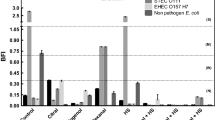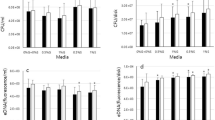Abstract
The impact of single-walled carbon nanotubes (SWCNTs) on Escherichia coli ATCC 8739 was investigated using four indicators of viability: enzyme activity, membrane integrity, plate count, and total RNA. The study examined the effects of SWCNT concentration (5, 10, 20, 50, 100, 200, 500, and 1,000 μg/ml), SWCNT length (0.5–2 and 5–30 μm), and bacterial density (6.5 log10 CFU and 9 log10 CFU per treatment) on E. coli ATCC 8739 viability. Results show that anti-bacterial activity is dependent on both the length and concentration of SWCNTs. Long SWCNTs (5–30 µm) were more toxic for E. coli than short SWCNTs (0.5–2 µm). The susceptibility of E. coli to SWCNTs was dependent on the initial density of cells in the treatment, with cells at the higher density being more resistant. Estimates of viability reductions were generally similar for the four assays examined; however, the beta galactosidase and LIVE/DEAD assays were more conservative than the plate count as indicators of viability reductions.






Similar content being viewed by others
References
Ajayan PM, Ebbesen TW (1997) Nanometre-size tubes of carbon. Rep Prog Phys 60(10):1025
Al-Hakami SM, Khalil AB, Laoui T, Atieh MA (2013) Fast disinfection of Escherichia coli bacteria using carbon nanotubes interaction with microwave radiation. Bioinorg Chem Appl 2013:458943
Arias LR, Yang L (2009) Inactivation of bacterial pathogens by carbon nanotubes in suspensions. Langmuir 25(5):3003–3012
Boulos L, Prevost M, Barbeau B, Coallier J, Desjardins R (1999) LIVE/DEAD BacLight®: application of a new rapid staining method for direct enumeration of viable and total bacteria in drinking water. J Microbiol Methods 37(1):77–86
Chen H, Wang B, Gao D, Guan M, Zheng L, Ouyang H, Chai Z, Zhao Y, Feng W (2013) Broad-spectrum antibacterial activity of carbon nanotubes to human gut bacteria. Small 9(16):2735–2746
Condon C (2007) Maturation and degradation of RNA in bacteria. Curr Opin Microbiol 10(3):271–278
Dresselhaus MS, Dresselhaus G, Jorio A, Souza Filho AG, Pimenta MA, Saito R (2002) Single nanotube Raman spectroscopy. Acc Chem Res 35(12):1070–1078
Fiksdal L, Pommepuy M, Caprais MP, Midttun I (1994) Monitoring of fecal pollution in coastal waters by use of rapid enzymatic techniques. Appl Environ Microbiol 60(5):1581–1584
George I, Petit M, Servais P (2000) Use of enzymatic methods for rapid enumeration of coliforms in freshwaters. J Appl Microbiol 88(3):404–413
George I, Petit M, Theate C, Servais P (2001) Use of rapid enzymatic assays to study the distribution of faecal coliforms in the Seine river (France). Water Sci Technol 43(12):77–80
Gwon YH, Ha JK, Cho KK, Kim HS (2012) Physical and electrochemical properties of synthesized carbon nanotubes [CNTs] on a metal substrate by thermal chemical vapor deposition. Nanoscale Res Lett 7(1):61
Kang S, Pinault M, Pfefferle LD, Elimelech M (2007) Single-walled carbon nanotubes exhibit strong antimicrobial activity. Langmuir 23(17):8670–8673
Kang S, Herzberg M, Rodrigues DF, Elimelech M (2008) Antibacterial effects of carbon nanotubes: size does matter! Langmuir 24(13):6409–6413
Kang S, Mauter MS, Elimelech M (2009) Microbial cytotoxicity of carbon-based nanomaterials: implications for river water and wastewater effluent. Environ Sci Technol 43(7):2648–2653
Liu X, Ng C, Ferenci T (2000) Global adaptations resulting from high population densities in Escherichia coli cultures. J Bacteriol 182(15):4158–4164
Ozkanca R (2002) Beta-galactosidase activity of Escherichia coli under long-term starvation, alterations in temperature, and different nutrient conditions in lake water. Int Microbiol 5(3):127–132
Parise A, Thakor H, Zhang XQ (2013) Activity inhibition on municipal activated sludge by single-walled carbon nanotubes. J Nanopart Res 16(1):2159
Pasquini LM, Hashmi SM, Sommer TJ, Elimelech M, Zimmerman JB (2012) Impact of surface functionalization on bacterial cytotoxicity of single-walled carbon nanotubes. Environ Sci Technol 46(11):6297–6305
Rompre A, Servais P, Baudart J, de-Roubin MR, Laurent P (2002) Detection and enumeration of coliforms in drinking water: current methods and emerging approaches. J Microbiol Methods 49(1):31–54
Simon-Deckers A, Loo S, Mayne-L’hermite M, Herlin-Boime N, Menguy N, Reynaud C, Gouget B, Carriere M (2009) Size-, composition- and shape-dependent toxicological impact of metal oxide nanoparticles and carbon nanotubes toward bacteria. Environ Sci Technol 43(21):8423–8429
Smart SK, Cassady AI, Lu GQ, Martin DJ (2006) The biocompatibility of carbon nanotubes. Carbon 44(6):1034–1047
Tryland I, Fiksdal L (1998) Enzyme characteristics of beta-D-galactosidase- and beta-D-glucuronidase-positive bacteria and their interference in rapid methods for detection of waterborne coliforms and Escherichia coli. Appl Environ Microbiol 64(3):1018–1023
Vecitis CD, Zodrow KR, Kang S, Elimelech M (2010) Electronic-structure-dependent bacterial cytotoxicity of single-walled carbon nanotubes. ACS Nano 4(9):5471–5479
Yang C, Mamouni J, Tang Y, Yang L (2010) Antimicrobial activity of single-walled carbon nanotubes: length effect. Langmuir 26(20):16013–16019
Yu MF, Files BS, Arepalli S, Ruoff RS (2000) Tensile loading of ropes of single wall carbon nanotubes and their mechanical properties. Phys Rev Lett 84(24):5552–5555
Acknowledgments
This material is based upon work supported by the National Science Foundation under Grant No. 1001216. Any opinions, findings, and conclusions or recommendations expressed in this material are those of the authors and do not necessarily reflect the views of the National Science Foundation. Stipend for supporting the first author was provided by Vietnam International Education Development, and Environmental and Conservation Sciences Program and Department of Civil and Environmental Engineering, North Dakota State University.
Author information
Authors and Affiliations
Corresponding author
Rights and permissions
About this article
Cite this article
Le, T.T.A., McEvoy, J. & Khan, E. The effect of single-walled carbon nanotubes on Escherichia coli: multiple indicators of viability. J Nanopart Res 17, 32 (2015). https://doi.org/10.1007/s11051-014-2827-y
Received:
Accepted:
Published:
DOI: https://doi.org/10.1007/s11051-014-2827-y




